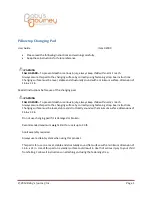
Performance veri
fi
cation
11.
Perform a linear
fi
t of the measured data points in the preceding table and record the linear
fi
t values in the table.
12.
Divide the measured linear
fi
t slope by the slope of the DC source voltage points. (See page 30,
13.
Record the Measured Gain value in the test record. (See page 34.)
DC gain measurement example
1.
The following table lists example measured values.
Table 10: Example DC gain measurements
Index
DC source voltage
Vout (measured)
Vout (linear
fi
t)
–2
–640 mV
–513 mV
–514 mV
–1
–320 mV
–256 mV
–257 mV
0
0 mV
0.0009 mV
0 mV
1
320 mV
258 mV
257 mV
2
640 mV
515 mV
514 mV
2.
The graph below show the plotted example values.
Figure 8: Example plot of measured values
The gain slope can either be obtained by using a spreadsheet to calculate the linear regression of the points, or graphically
by hand. To obtain the gain slope graphically, carefully plot each measurement point on a rectangular coordinate system,
the X axis is the DC source voltage and the Y axis is the measured DC output value. Using a straight edge, draw a line
through the points, minimizing the error between the line and each point. The gain slope is taken by the slope of the
drawn line (rise in Y divided by run in X), and the zero point error taken at the point at which the line crosses the Y axis.
The DC output value can be predicted by the following equation:
3.
The following table shows the measured gain as calculated from the slopes of the plotted measured values.
30
TPR1000 and TPR4000 User Manual








































